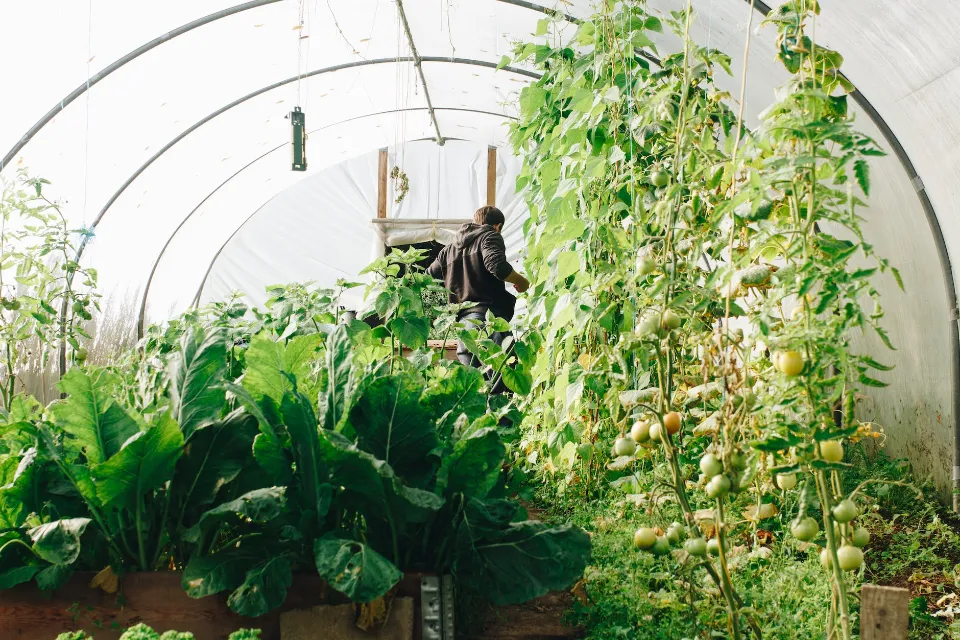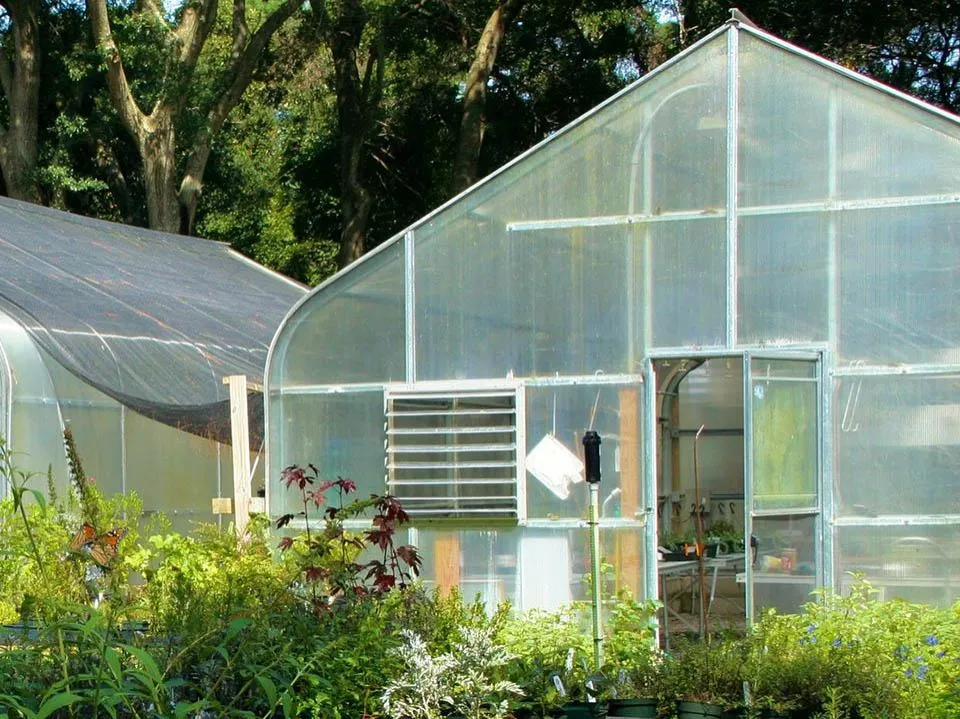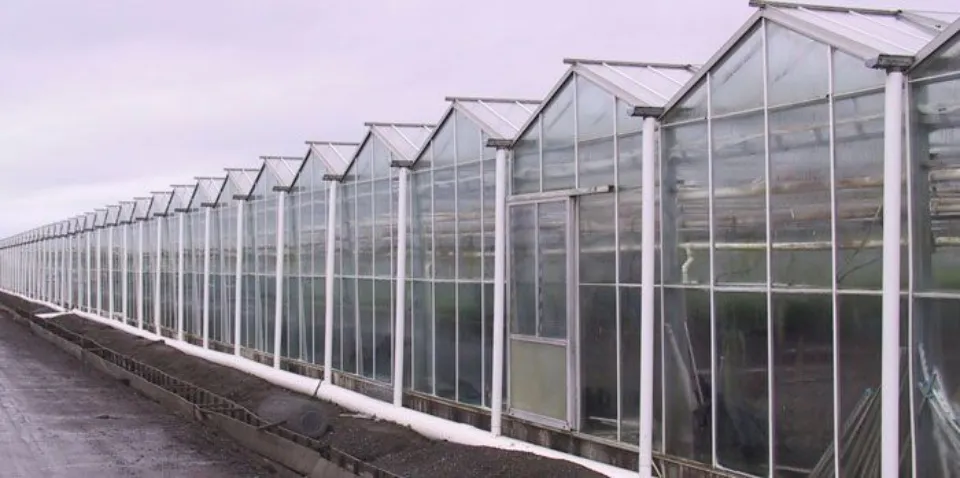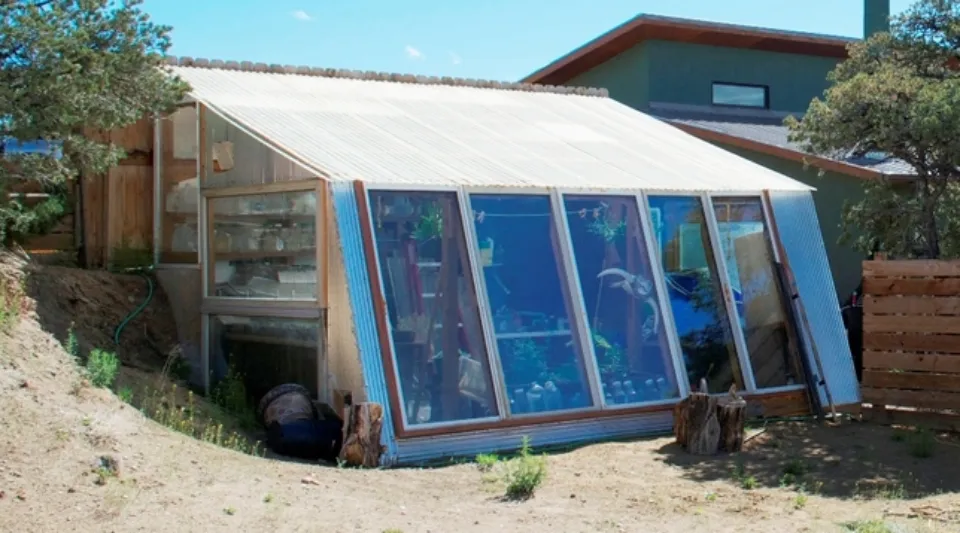You can use your green thumb throughout the year in a greenhouse. Choose the type of greenhouse that suits your yard, and your gardening dreams can come true.
Most common types include lean-to greenhouse, PVC or polyester plastic greenhouse material, ridge and furrow greenhouse and more
We’ll outline the varieties and production techniques that work best in greenhouses in today’s article. We must first define a greenhouse and understand its purpose before moving forward.
Table of Contents
What is a Greenhouse?
It’s right there in the name: A greenhouse is a structure where vegetation grows inside. It offers the perfect setting to regulate temperature, increase irrigation efficiency, and magnify or dim sunlight as needed.
Growing plants in a greenhouse is rarely as easy as erecting a structure and bringing the plants inside.
All of this is made possible by transparent roofing and insulating walls, regulated ventilation, and simple access to water. Some greenhouses do not enhance light. For plants that can’t stand intense sunlight and high temperatures, some people offer shade. A diverse ecosystem can thrive when some areas have both sunny and shady areas.
Related Post: How Does A Greenhouse Work?
10 Different Types of Greenhouses

A greenhouse can be categorized in part by the structural style or shape of the building. Before making a purchase, it is important to weigh the advantages and disadvantages of each structure.
On the basis of the frame material and outer covering material, you can further classify various greenhouse types. Here are the various types of greenhouses available in the market.
1. Lean-To Greenhouse
This category includes greenhouses that are attached to one side of an existing building or placed up against one of its sides. You can place the greenhouse walls between two buildings or use them as one of the greenhouse’s sides. Lean-to greenhouses only have three or two sides that can be covered with greenhouse sheeting material, as well as the roof, to create a complete enclosure.
Most lean-to greenhouses and window-mounted greenhouses have a maximum height of 12 feet and can only hold one or two rows of plants at once. But if you make sure it receives enough light, you can extend it against an even longer wall.
Pros
- a short distance from the main building’s water and electricity, among other amenities.
- Less material is needed for smaller structures.
- needs a little space to set up.
- less support is needed for the roof.
Cons
- For plants, there isn’t much room.
- For healthy plant growth, there is not enough exposure to light.
- The wall sides make it challenging to regulate the temperature.
- Because of the supporting wall, there is a height restriction.
2. PVC Or Polyester Plastic Greenhouse Material

PVC plastic is among the materials used most frequently to cover greenhouses. Because it is transparent, sunlight can pass through and reach the plants. Additionally, you avoid paying for greenhouse heating and maintenance costs.
Pros
- Readily available.
- allows a lot of sunlight to enter.
- It was cheap.
- Both setup and weight are convenient.
Cons
- Eventually vulnerable to damage
3. Ridge and Furrow Greenhouse

The A-frame-like ridge and furrow structure is yet another ideal illustration of a structural greenhouse type. The A-frame greenhouse buildings are connected to one another in a tidy row in the design. Each row is associated with the eave, where all extra snow and rain drains off.
An A-frame building with steel-blue roof shingles and white or dark wood paneling has a traditional country appearance. Simple materials can be used to build it, making it cheap to make. Very little wood or plastic film from your home may be used to construct this greenhouse.
It also necessitates little expertise in building. The peaks may be harder to maneuver due to their wide base and short height, and they are low in elevation. Around the lower edges and sharp angles, airflows are not always optimal.
When there are many greenhouses on a big farm and you don’t want any of them getting damaged by snow or rain, this particular design is very common. In addition to increasing the area for more sunlight penetration, connecting multiple greenhouses adds additional growing space.
Pros
- There is still space inside the building for plants to grow.
- helps to conserve energy and automation.
- prolongs the life of the structure by removing snow and rain from the roof.
- An appealing look.
Cons
- Expensive to set up.
- a sizable amount of land is needed.
4. Gothic Arch Greenhouses
A gothic arch greenhouse can easily be visualized by thinking of any Gothic building you have ever seen. Because of its distinctively pointed roof, trusses on the greenhouse’s structure are less necessary. A structure like this is perfect for both personal and professional use because it can be made in any size.
To choose the desired size, all you need to do is keep track of your expenses and available space. Before choosing, think about the advantages and disadvantages of the Gothic arch greenhouse.
Pros
- It is versatile because it can be either a large or small structure.
- Appealing to look at.
- It makes it simple for snow and rain to drain off.
- Trusses are not required.
Cons
- When compared to other types of greenhouses, it uses up more materials.
- The corners don’t get enough airflow because of this.
5. Uneven Span Greenhouse

You’ll notice the uneven-span greenhouse has a distinguishing characteristic. This building’s name comes from the fact that one of its roofs is longer than the other. When the greenhouse structure is in a hilly area, the main purpose of the design is to allow more sunlight intake.
The longer roof side, which typically faces south, must be transparent. This kind of greenhouse is less common now that most are located in flat terrain.
Pros
- It aids in the plants’ access to sunlight.
- controls the wind.
- Structure that is strong and durable.
Cons
- For flat areas, not recommended.
6. Pipe Metal Frame Greenhouses
Heavy-duty metals like steel and aluminum are commonly used in pipe-framed greenhouse construction. The greenhouse can be used for a very long time because these metals are durable.
As soon as you decide on a metal pipe frame structure, be sure to research the metals used because some are more prone to corrosion than others. Additionally, if the greenhouse is being built for commercial use, it is wise to use sturdy metal to avoid having to pay to replace rusted-out pipes.
Pros
- makes use of strong metal.
- It offers a resilient structure that can withstand the elements.
- Metal frame structures are heat resistant even in extreme temperatures.
Cons
- Heavy-duty metal is pricy.
7. Wooden Frame Greenhouses
A wooden frame supports the majority of cold climate weather greenhouses, which helps retain heat inside. The majority of these are compact arrangements used to store plants until spring in backyards. Even without hiring a specialist, building the greenhouse is simple to do with wood that is widely accessible.
Pros
- The greenhouse keeps warm during the chilly winter months thanks to its high thermal efficiency.
- construct and repair with ease.
- Wood has a beautiful appearance by nature, especially when the grain is visible.
- Environmentally friendly, the timber frame.
Cons
- When it is not locally sourced, wood is expensive.
- It is vulnerable to insect attacks if not treated properly.
8. Even Span Greenhouse
These greenhouses can be recognized by their two distinct sloping roofs. This design can be used to set up a small greenhouse in your backyard depending on your measurements.
When you set it up, you might want to think about mounting one end to the house or leaving it to stand alone in the garden. Additionally, you can build it as large as you can to accommodate additional rows and shelves with lots of plant life. Transparent glass or other materials cover every area, allowing plants to receive enough sunlight.
However, the cost of heating such a large space may be higher. If it gets chilly out during the day and night, you might need to install a heating system to keep things from getting too cold.
Pros
- Adaptable architecture that won’t place size restrictions on you.
- large enough to carry lots of plants.
- a perfect form that maintains temperature uniformity.
- Snow and rain runoff are prevented by the A-frame roof.
Cons
- Expensive to set up.
- own heating system is required.
0. Plastic Greenhouses
Quality greenhouses made of durable plastic are particularly useful for indoor use and protection from wind. You might want to take into account greenhouses with plastic frame construction as you look into various affordable greenhouse options. You won’t have to go over budget to set one up because the material is affordable.
Pros
- The cost of plastic greenhouses is low.
- The frame is made of sturdy plastic.
- Unlike wood greenhouses, they are not easily damaged.
- They are simple to wash.
Cons
- Large structures are not best served by plastic frames.
10. Glass Material Greenhouses
Another high-quality material that is used to cover various greenhouse types is glass. It enables deeper light intensity, which is perfect for healthy plants. Additionally, it enables sufficient air filtration, which is the most effective way to manage the humid environment.
Pros
- permits more light to enter.
- enables thorough air filtration.
- Appealing to look at.
Cons
- Glass is expensive to use, especially in a large greenhouse.
Benefits of Having a Greenhouse
Regardless of the kind you pick, having a greenhouse has many advantages. Plants thrive in the controlled environments that greenhouses offer.
Greenhouses aid in extending the growing season and enabling year-round gardening by shielding plants from extreme weather conditions. You can grow organic food without the use of harmful chemicals by using greenhouses to protect plants from pests.
Read More: How To Keep A Greenhouse Warm In The Winter?
What Features Should You Look for When Choosing a Greenhouse?
Picking a greenhouse involves taking into account a number of factors. The size, type of substance, and type of ventilation are the key factors to consider.
Because you need to make sure the greenhouse is large enough to hold all of your plants, size is crucial. The space you have available should also be taken into account. You might want to go with a smaller greenhouse or an attached greenhouse if your yard is small.
The greenhouse’s durability and cost will depend on the material choice, which is crucial. The oldest and most expensive greenhouses are made of wood. Greenhouses made of metal and plastic are less expensive but less long-lasting.
The type of ventilation is crucial because it will influence the greenhouse’s internal temperature. Choose a greenhouse with good ventilation because they can get very hot in the summer. There is excellent natural ventilation in gable greenhouses and hoop greenhouses.
You’re prepared to select the ideal greenhouse for your needs now that you are aware of the various types and what features to look for.
Also Read: How Much Does A Greenhouse Cost?
Final Thoughts on Types of Greenhouse
Here is all about types of greenhouses you should know.
Choosing between the different types of greenhouse for your space needn’t be tricky. It’s much simpler to narrow down your options and choose the best option for your outdoor space once you are aware of what is available and the differences between them. We can be of assistance in that situation.
Read More: Greenhouse Gardening
FAQs
Should a Greenhouse Have a Floor?
One of the most important reasons to install a floor in your greenhouse is to provide a surface that is durable and easy to clean. It will be simpler to keep the interior clean and will be protected from moisture and pests by a good greenhouse floor.
What is the Cheapest Way to Heat a Greenhouse?
Heating a greenhouse with gas is the least expensive option.
Where Should You Not Put a Greenhouse?
Any tall trees should not be placed beneath a greenhouse as they significantly reduce the amount of sunlight that reaches your plants.

















